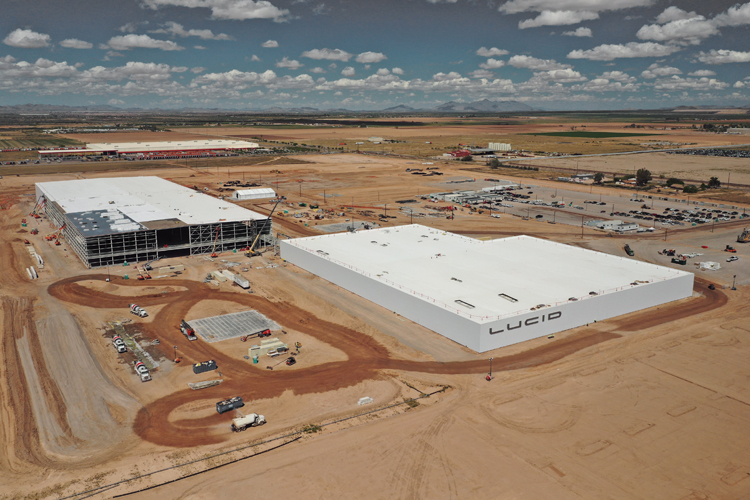Situated midway between Arizona’s two largest cities, Phoenix and Tucson, Pinal County has long lived in the shadows of its more well-known neighbors — a drive-through county in which travelers only stop when they need to get gas. But recent growth in infrastructure and the commitment by major electric vehicle manufacturers have set the groundwork for an impending boom in commercial and residential development.
“Pinal County sits at the epicenter of two big cities and is the point of intersection where all infrastructure in the state comes through,” says Jackob Andersen, president and CEO of Saint Holdings, the developer behind some of the county’s largest land deals, including two massive industrial parks.
READ ALSO: Drive48 boosts training efforts for high-tech jobs in Coolidge
Just under a year after breaking ground in Casa Grande, Lucid Motors finished construction on its first electric vehicle factory in December. Lucid Motors broke ground on the first greenfield, dedicated electric vehicle factory built in North America less than a year earlier, with the innovative AMP-1 factory now standing ready to start production of the next-generation EV, Lucid Air, this year.
Pinal County offers easy access
When it comes to transportation, Pinal County is ideally suited for road, rail and air travel.
Located about 55 minutes from Phoenix and 35 minutes from Tucson, the county is at the confluence of two major highways: Interstate 10, the fourth-longest interstate in the U.S., which stretches from Santa Monica, California, to Jacksonville, Florida; and Interstate 8, which branches off of I-10 just southeast of Casa Grande and runs to San Diego.
“Ever since I-10 came into being, Eloy has reaped the benefits through truck stops,” says Jeff Fairman, economic development manager for the City of Eloy. “There must be nine different truck stops along the interstate in our city alone. They all have restaurants and
some even have services such as barbershops.” January saw the opening of an Xpress Fuel travel center, which added about 50 jobs to the community and is expected to contribute $2.24 million annually in state and local tax revenues.
The main line of the Union Pacific Railroad connects Casa Grande to major ports and transfer points in Los Angeles and El Paso, Texas. It links 23 states, connects with Canada’s rail systems and is the only railroad serving six major destinations in Mexico. “Part of the reason Lucid Motors chose the develop in Casa Grande is that there’s already an existing automotive base in Sonora, Mexico, that can supply parts,” Andersen notes.
Finally, the county offers easy access to three major international airports. Phoenix Sky Harbor, Phoenix-Mesa Gateway and Tucson International are all within an hour’s drive from just about any location in the county. Phoenix-Mesa Gateway is also home to SkyBridge Arizona, the nation’s only joint U.S.-Mexico customs inspection facility, which streamlines shipments to and from Mexico.
As the county continues to grow, the number of vehicles coming in and out of, and passing through, the region is expected to increase dramatically. Gov. Doug Ducey approved new infrastructure investments, including $33 million to rebuild the Gila River Bridge on I-10 between Phoenix and Casa Grande.
The project will widen the bridge to
three lanes in each direction, paving the way for a full expansion of the highway.
“The only section of I-10 that hasn’t been widened is between Chandler and Casa Grande,” says Richard Wilkie, economic development director for the City of Casa Grande. “The additional lanes are going to make commerce so much easier.” Construction on the bridge is set to begin this year, with completion of all improvements expected by 2023.
The price is right
The intense competition for land in Maricopa County has resulted in escalating building costs. “Prices in the Valley are increasing exponentially right now,” says Elan Vallender, economic development director for the Town of Florence. “Land is definitely less expensive out here, and that’s a great draw.” Andersen notes that land prices in Pinal County are about 50%
to 60% cheaper than in Metro Phoenix.
With thousands of acres of undeveloped land that is zoned for industrial use or can be quickly zoned heavy industrial, multiple shovel-ready industrial parks and robust infrastructure, including water, power, sewer and fiber, the region is primed for large-scale development.
“Most of the undeveloped land in Casa Grande is ready to go,” Wilkie says. “You come in here, and it’s either plug-and-play or it’s a short distance to connect to the utilities of your need.” A large portion of Pima County, including almost 10,000 acres in Casa Grande, the entire town of Superior and areas along I-10 in Eloy, have also been federally designated as opportunity zones, meaning that private investments may be eligible for capital gain tax incentives.
“Eloy is 113 square miles that stretch from State Route 87 to the northeast and almost to the reservation to the south, and our planning area is even larger than that, so we’re set with available land, quite frankly, for forever,” Fairman explains. “Because we’re a city, we also have a 100-year assured water supply for both residential and commercial development. That’s something a lot of places can’t offer anymore.”
Housing boom
The low cost of land also translates to lower housing prices. “There are a lot of people who are still interested in owning a little bit of land with their house and having a yard where their kids can play, but they’ve been priced out of Phoenix and Tucson,” Fairman says. Investments by large-scale employers, such as electric vehicle manufacturers Lucid Motors and Nikola, have also added to the area’s appeal, bringing in workers and their families who wish to live near their job sites.
Saint Holdings is currently developing a 4,000-home master-planned community in Casa Grande, while other lots that have remained vacant for years are being snapped up by builders, including Shea Homes, Lennar, Richmond American and more. “We did more than 1,100 new single-family residence permits last year, and this year we’re on pace to beat that,” Wilkie says. “Lucid Motors has definitely been the beacon.”
Fairman adds that in Eloy, 90 vacant lots that had never been fully developed were recently picked up. “They’re building homes on all of those lots, three, four, five at a time,” he says, adding that Robson Ranch, a
55+ community in Eloy, has been adding 100 new homes a year.
“When companies are making site selections, they’re looking for the location, the land, the affordability of the land, the infrastructure, the workforce, connectivity to transportation systems and quality of life,” Wilkie says. Once overlooked, Pinal County is prepared to meet those demands.




